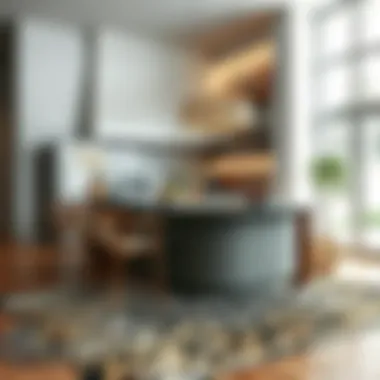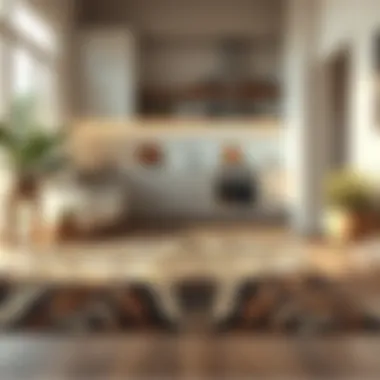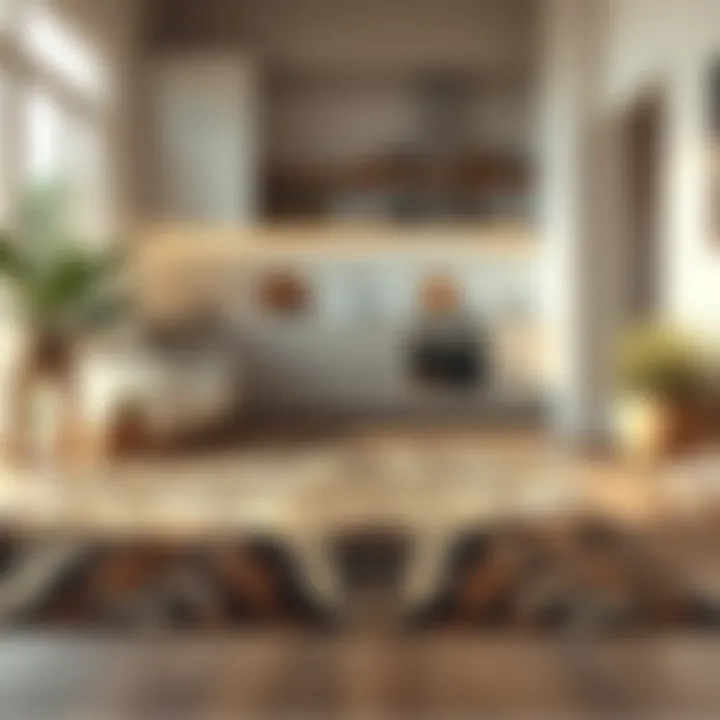The Effect of Animal Print Kitchen Rugs on Interior Spaces


Intro
When it comes to transforming the heart of a home—the kitchen—often overlooked details can make a significant impact. Among these details are the kitchen rugs, and in recent years, animal print has taken the spotlight. Animal print kitchen rugs might seem like a bold choice, but they offer a cacophony of designs that can enhance your culinary space in ways you might not expect.
Whether your kitchen vibe is contemporary, rustic, or eclectic, an animal print rug can be the perfect finishing touch. From adding a touch of sophistication to injecting a sense of fun, these rugs can unify various design elements. The interplay of colors and patterns found in animal prints not only fulfills decorative needs but also resonates with functionality, allowing homeowners to create a unique ambiance without compromising on practicality.
This article endeavors to unravel the complex dynamics of incorporating animal print kitchen rugs into interior design. Dive into current trends, material considerations, and the maintenance required to keep these styles looking fresh. Whether you're a seasoned designer or a homeowner looking for that wow-factor, there's something here for everyone.
By the end of this read, we hope you’ll feel empowered to curate a kitchen space that truly embodies your style while showcasing the versatility and charm that animal prints can bring.
Foreword to Animal Print Kitchen Rugs
When stepping into the world of interior design, the integration of animal print kitchen rugs can often be overlooked. Yet, these rugs can transform a mundane cooking space into a vibrant and sultry backdrop. They serve not just a functional purpose, offering comfort underfoot, but also elevate the aesthetic value of the kitchen.
Significance of Animal Prints
Animal prints in kitchen rugs aren't merely for show; they encapsulate a rich tapestry of cultural associations and historical contexts that offer a unique charm. Whether it's leopard, zebra, or more exotic snake skin designs, these patterns have a way of adding character to spaces that are often too utilitarian. In a realm that typically prioritizes function, the right rug can add a splash of fierce style.
Benefits of Incorporating Animal Prints
- Versatility: Animal print rugs harmonize with various decor styles. Whether you're aiming for rustic charm with wooden cabinetry or modern chic with sleek lines, these rugs round off the ambiance beautifully.
- Visual Interest: A solid-color rug might blend into the background, but a patterned rug can serve as a conversation starter. It breaks the monotony and makes the kitchen more inviting.
- Durability: Many animal print rugs are crafted from materials that withstand wear and tear, making them not only aesthetically pleasing but also practical.
Things to Consider
Choosing an animal print rug isn't just about selecting a pattern. It’s a matter of style compatibility, color schemes, and material choices. A rug that catches the eye can also misalign with the overall scheme if not chosen wisely. Think about the room’s function and how the rug will engage with your kitchen activities. For instance, in a kitchen that boasts a bright palette, an exciting zebra print might just be the right spice to elevate the design.
Overall, the introduction of animal print kitchen rugs into your interior design narrative can make a world of difference. They embody a mix of tradition, boldness, and elegance—and when done right, they create a kitchen that’s not just a functional space but a stylish statement.
Understanding Animal Print Trends
In the sphere of interior design, the nuances of color, texture, and pattern play a significant role in shaping environments that are not only functional but also visually arresting. The understanding of animal print trends is paramount when considering the incorporation of these engaging patterns into kitchen spaces. Animal prints serve as a bridge between the wild aesthetics of nature and the structured designs of modern dwellings. They evoke a sense of both adventure and sophistication, making them versatile in various decorating schemas.
Exploring animal print trends unveils layers of complexity that cater to various tastes and preferences. They act as a canvas for personal expression, reflecting an individual's style whilst synchronizing with the overall decor of the kitchen. The key here lies in strategic selection and placement. The right animal print, when matched with the appropriate materials and colors, can enhance the entire ambiance of the kitchen.
Benefits of Understanding Animal Print Trends
- Aesthetic Appeal: Animal prints can dramatically elevate the visual interest within a space. They can serve as a focal point or a complementary feature, depending on the desired effect.
- Cultural Significance: Various animal prints carry cultural connotations. For instance, leopard prints are often associated with luxury and glamour, while zebra prints might evoke a sense of exoticism.
- Adaptability: These patterns can align with multiple styles, be it modern, rustic, or eclectic. Understanding current trends helps integrate them seamlessly into various design frameworks.
- Timeless Quality: Although styles may evolve, animal prints have a history of remaining popular. Their ability to meld with contemporary and classic schemes alike makes them an enduring choice.
Thus, grasping the intricacies of animal print trends is not merely about decorating a kitchen. It's about crafting a narrative that resonates with both the space and its inhabitants.
Historical Context of Animal Prints
Animal prints have weaved through the fabric of history, bouncing back and forth between authenticity and imitation. Initially, these prints emerged as a symbol of status. In ancient times, wearing animal skins was about survival, but it transformed into a sign of power and prestige as societies evolved. From the stately garments of emperors draped in tiger and leopard skins to contemporary runway shows showcasing daring designs, the journey of animal prints encapsulates various cultural shifts and artistic expressions.
In the mid-20th century, famous fashion figures began to shine a spotlight on these prints, pushing them beyond the realm of clothing into the broader landscape of interior design. For instance, the glamour of the 1960s and 70s ushered in an era where bold patterns began to feel at home in living spaces, particularly in high-fashion circles. This paved the way for modern interpretations that challenge conventional design boundaries. In essence, animal prints transitioned from symbols of raw power to statements of chic decoration that continue to captivate today.
Current Design Trends Featuring Animal Prints
As of recent years, animal prints have been making a grand comeback, albeit with a twist. The trend now leans towards bolder interpretations that foster creative experimentation. Designers are moving away from conventional placements and exploring innovative designs that bring a fresh vibe to interiors.
Some trends worth noting include:
- Mixed Patterns: The current design ethos celebrates the mixing of different animal prints with florals or geometric designs. This creates an audacious yet harmonious visual narrative.
- Muted Hues: While classic bright animal prints hold their ground, muted tones are becoming increasingly popular. Beige leopard or soft gray zebra prints offer subtlety without sacrificing style.
- Focus on Texture: New materials are being used to replicate animal skins, with an emphasis on tactile experiences. Textured fabrics add another dimension to the prints, making them feel more organic.
- Eco-Friendly Options: The growing emphasis on sustainability has led to an increase in animal prints made from recycled materials or organic cotton, appealing to the environmentally conscious consumer.
These emerging trends indicate that animal prints are not just a passing phase; they are evolving and adapting to meet contemporary tastes while honoring their rich heritage in the world of design.
Types of Animal Prints in Rugs
When it comes to interior design, the type of animal print you choose for your kitchen rug can speak volumes about your style sensibility. Not only do these prints add flair, but they also create a unique focal point in the room. The significance of animal print rugs lies in their ability to blend aesthetics with practical functionality.
Choosing the right type of animal print can influence the overall mood and design harmony of a kitchen space. The three main prints that have captured the hearts of many homeowners are leopard, zebra, and snake skin. Each of these prints presents distinct characteristics that can complement various decor styles.
Leopard Print
Leopard print is often seen as a bold statement in interior design. It carries an air of sophistication and wild charm, making it a popular choice for those who want to inject a bit of personality into their kitchen. The rich, golden hues of leopard print can warm up a room and create an inviting atmosphere.
Furthermore, leopard print rugs can serve as a neutral backdrop against vibrant colors in your kitchen, allowing other elements to shine. They work particularly well with wooden surfaces and metallic accessories, bridging rustic and modern aesthetics effortlessly.
In terms of maintenance, leopard print rugs can hide stains and dirt better than solid colors, making them a practical choice for busy kitchens. The varied patterns of a leopard print also mean minor spills might blend in, thus reducing the frequency of deep cleans.
Zebra Print
Zebra print often commands attention, drawing the eye to its striking black-and-white contrasts. This type of rug can transform a kitchen into a stylish and contemporary space. Zebra prints have an inherent modernity that pairs excellently with sleek design elements like stainless steel appliances or glossy finishes.
A zebra print kitchen rug can create a cohesive look when balanced with solid color cabinets or layering textured materials. For those who lean towards monochromatic palettes, a zebra print adds just the right amount of visual interest without overwhelming the senses.


Moreover, maintenance tends to be straightforward, as the bold contrasts can help camouflage crumbs and dust. A quick swipe with a broom or vacuum usually does the trick.
Snake Skin and Other Designs
Snake skin print rugs present an exotic flair, reminiscent of the adventure and allure of nature itself. Whether you're aiming for a warm, earthy tone or a more iridescent design, this print offers a unique option that stands out.
When placed in a kitchen, snake skin rugs can create a luxurious feel, inviting warmth and a subtle exotic touch to the space. The ribbon-like patterns can serve as an exquisite contrast against bright-colored walls or serve to elevate the elegance of neutral tones.
In a similar vein, other animal prints, such as those imitating ostrich or alligator patterns, can also bring about different textures and colors into kitchen decor, promoting variety. While embracing these unique styles, one must consider that the maintenance might vary; thus, choosing the right material is essential to retain their beauty.
"Animal prints are not merely a trend; they are a statement of individuality that brings vitality and character to any living space."
In summary, when selecting animal print kitchen rugs, it’s important to consider what vibe you want to convey. Whether it be the wild charm of leopard, the striking elegance of zebra, or the exotic allure of snake skin, each type has its hallmark features that can beautifully merge the practical aspects of kitchen life with creative expression.
Material Selection for Durability
When delving into the world of animal print kitchen rugs, one cannot overlook the significance of material selection. Choosing the right material is fundamental, not only for aesthetics but also for the longevity of your rug. After all, a kitchen is a high-traffic area, constantly subjected to spills, stains, and foot traffic. Hence, the durability of your rug is paramount.
Rugs made of certain materials will withstand the daily wear and tear more effectively than others, providing a solid return on your investment. Durable rugs can save you the headache of frequent replacements while maintaining a fresh and stylish look in your kitchen.
Choosing the right material can also contribute to how well the rug integrates into the overall design and functionality of your kitchen. Below, we will explore the options available, weighing the pros and cons of each.
Natural Fibers vs. Synthetic Options
When it comes to kitchen rugs, you usually have two primary categories: natural fibers and synthetic options. Each comes with its unique charms and drawbacks.
- Natural Fibers: These include materials like wool, cotton, and jute. They often bring a luxurious feel and warmth to your space. Wool, for instance, is known for its softness and durability. However, it can be more susceptible to stains and is often pricier. Cotton offers ease of cleaning but may not be as durable as other options. Jute is eco-friendly and offers great texture but might not handle moisture well in a kitchen environment.
- Synthetic Options: On the flip side, synthetic materials such as nylon, polyester, and polypropylene are engineered for resilience. Nylon is particularly popular due to its toughness and resistance to staining. Polypropylene rugs are often treated to repel water and are usually the most cost-effective choice, making them ideal for spill-prone areas like kitchens.
Both types have their place, but the decision ultimately hinges on your individual needs and preferences.
Benefits of Eco-Friendly Rugs
Eco-friendly rugs have been gaining traction lately, and it’s easy to see why. Not only do they appeal to those with a green thumb, but they also bring additional benefits that can elevate your kitchen design.
- Sustainability: Choosing eco-friendly materials reduces your carbon footprint. Rugs made from recycled plastics, for example, help keep waste out of landfills while providing a unique look.
- Healthier Indoor Air Quality: Many synthetic rugs off-gas harmful chemicals. On the other hand, eco-friendly rugs are often organic and free from these toxins. Thus, they contribute to a healthier kitchen environment, especially crucial in a space where food is prepared.
- Durability and Performance: Surprisingly, eco-friendly rugs can also be quite durable. Many are made with advanced technology to ensure they stand up against daily use while being kind to the planet.
By choosing eco-friendly options, you not only add a stylish element to your kitchen but support sustainable practices that align with modern values.
Choosing the right material is key to ensuring your animal print kitchen rug stands the test of time, balancing aesthetics and functionality beautifully.
Functionality of Kitchen Rugs
When it comes to interior design, particularly in a bustling space like the kitchen, the functionality of kitchen rugs cannot be overstated. While many may focus primarily on the aesthetic appeal of animal print rugs, their practical benefits play a crucial role in enhancing a kitchen's overall environment. From safety to comfort, these rugs are not merely decorative but serve essential purposes that contribute to a homeowner’s day-to-day life.
Safety Considerations
One of the foremost elements to consider with kitchen rugs is safety. Kitchens can often become slippery due to spills and splashes, and a rug that lacks proper backing or grip can become a slipping hazard. Therefore, investing in animal print rugs with non-slip backing not only showcases your style but also helps prevent accidents. Look for materials that provide enough traction against the floor.
Additionally, when placed strategically in high-traffic areas, these rugs can cushion falls and lessen the impact on hard tile or wood floors. A well-placed rug can catch minor spills, which minimizes the risk of slips and keeps the floor from getting too slick.
"A kitchen rug can act as a silent protector, ensuring that your culinary sanctuary remains both stylish and safe."
Comfort Underfoot
Beyond safety, comfort underfoot is another compelling reason to incorporate animal print kitchen rugs. The kitchen is often a zone of constant activity, from cooking to entertaining, and a soft, cushioned rug can make a world of difference. Standing on hard surfaces can cause fatigue, soreness, and discomfort over time. A plush rug provides the relief that tired feet crave while offering support during longer cooking sessions.
The thickness and material of an animal print rug can vary greatly, so it’s important to choose one that meets your specific needs. For example:
- Memory Foam: Excellent at relieving pressure and contouring to your feet.
- Woven Fibers: Often provide a softer feel while also being very durable, standing up well to heavy foot traffic.
Moreover, an animal print can bring a touch of whimsy, contributing to a kitchen's character. All these factors combine to create a more inviting and functional workspace.
Styling Tips for Animal Print Kitchen Rugs
When it comes to interior design, styling is key. Animal print kitchen rugs bring a unique flair to spaces typically filled with traditional designs. These rugs not only serve a practical purpose but also enhance the aesthetic appeal of your kitchen, setting the tone for the entire area. Understanding how to wisely style these rugs is crucial for achieving a balanced and inviting atmosphere. Here’s a deep dive into the various factors influencing styling choices that can make or break the look of your kitchen.
Complementary Decor Styles
Modern
The modern style is all about sleek lines and minimalistic decor. In the context of animal print rugs, modern design integrates these bold patterns in a way that feels organic, rather than overpowering. Key characteristics of modern décor include simplicity and functionality. An animal print rug can accentuate this style by serving as a statement piece without cluttering the space.


The unique feature of modern styling is its focus on neutral and muted tones, which often work harmoniously with the vibrant colors found in animal prints. This combination can add visual interest while still maintaining an air of sophistication. However, one downside to consider is that if not carefully selected, a bold rug might clash with other elements in the kitchen that have the same level of intensity.
Rustic
The rustic style draws its charm from a warm and inviting appearance, showcasing the beauty of natural materials. Incorporating an animal print rug within a rustic kitchen can create a comfortable space that feels lived-in. The key characteristic here is the embrace of rustic elements like wood and stone, which complement the organic feel of animal print.
One unique feature of rustic decor is its ability to blend various textures and hues, making it easier to introduce an animal print without it appearing out of place. This not only enhances the design but also promotes warmth and coziness in a kitchen. However, one must tread carefully—too many contrasting prints may lead to a chaotic visual effect, so keeping other design elements subtle is beneficial.
Industrial
The industrial style is characterized by its raw and edgy aesthetic, focusing heavily on the use of metal and exposed structures. An animal print rug can serve as a surprising yet effective mix, softening the harsh lines often found in this decor style. The key characteristic here is the emphasis on an unfinished look, which can feel stark without additional warmth.
A unique feature of this combination is how animal prints can introduce softness and a touch of whimsy in an otherwise tough environment. When styled correctly, they can ground the space and create a sense of balance. On the flip side, there's a risk that an overly bright or busy animal print may clash with the rugged elements, so it is wise to choose more subdued colors that align with the industrial theme.
Color Coordination Strategies
Successfully introducing an animal print rug in your kitchen hinges significantly on color coordination. The rug should either complement or contrast effectively with the rest of your decor. Use color wheels or palettes to choose colors that harmonize well, creating a seamless transition from one design element to another. Generally, choosing more neutral shades within the print can help other vibrant kitchen components shine.
A good strategy is to work with three main colors: the primary color from the rug, a complementary one for the cabinetry or walls, and an accent shade perhaps found in your kitchen accessories.
Remember: The goal is to create an environment where each piece contributes to an overall harmonious aesthetic, rather than competing for attention.
Maintenance and Cleaning Considerations
When it comes to animal print kitchen rugs, maintenance and cleaning play a crucial role in preserving their aesthetic appeal and durability. Just like any beloved item in your home, these rugs require a little TLC to keep them looking sharp and functioning well. Neglecting proper care can lead to fading patterns, unpleasant odors, or even lasting damage. By implementing effective cleaning strategies, you can extend the lifespan of your rug while ensuring it remains a stunning centerpiece in your kitchen. Let's take a closer look at the different aspects involved in the care for these rugs.
General Care Tips
Keeping your animal print kitchen rug in top shape doesn't have to be a chore. Here are some straightforward strategies to adopt:
- Regular Vacuuming: Make it a habit to vacuum your rug at least once a week. This helps in removing crumbs and dust before they settle deeper into the fibers.
- Rotate Periodically: Rugs can wear unevenly depending on foot traffic patterns. Rotating them every few months keeps the wear and tear evenly distributed.
- Spot Cleaning: Don’t wait for major spills before acting. Quickly dab any minor stains with a clean cloth and a mild detergent.
- Avoid Direct Sunlight: Place rugs away from direct sunlight to prevent color fading. If your kitchen windows are particularly sunny, consider using sheer curtains or window film.
- Professional Cleaning: Depending on the rug’s material, consider having it professionally cleaned every couple of years to maintain its condition.
Stain Removal Techniques
Accidents happen, especially in a bustling kitchen. Knowing the right stain removal techniques can save you a lot of heartache. Here are some effective methods:
"A stitch in time saves nine"—taking care of stains immediately can prevent bigger problems later.
- Grease Stains: For grease, sprinkle baking soda over the area and let it sit for a while to absorb the oil. Then, vacuum it up and follow up with a damp cloth using a mild detergent.
- Food Spills: Blot the spill promptly. For tougher stains like tomato sauce or red wine, a mixture of white vinegar and water works wonders. Apply the solution and blot again.
- Coffee Stains: To tackle coffee stains, mix dish soap with water and apply it gently to the area. Rinse with a damp cloth and repeat if necessary.
- Pet Messes: If you’re an animal lover, you know ‘the mess’ is bound to occur. Clean up quickly with an enzymatic cleaner to neutralize odors and prevent your pet from returning to the same spot.
Case Studies of Successful Designs
In this section, we delve into the significance of showcasing successful applications of animal print kitchen rugs in interior design. These case studies serve as tangible evidence of how these rugs can transform a space, adding character and flair. By examining the choices made by designers and homeowners alike, readers can draw valuable lessons on blending aesthetics with functionality, which ultimately enriches their design journey.
Inspiration from Notable Designers
The influence of notable designers on the use of animal print kitchen rugs cannot be overstated. Renowned design figures often set trends and create benchmarks for style that others aspire to reach. For instance, Kelly Wearstler, known for her eclectic style, has often incorporated leopard print rugs in her kitchen designs, demonstrating how bold patterns can create focal points in otherwise neutral spaces. Her work exemplifies the daring approach of mixing textures and prints to establish an inviting atmosphere.
Similarly, Nate Berkus has successfully used animal print in various home settings. His ability to marry sophistication with a relaxed vibe reflects how animal prints can not only work for playful themes but also elevate traditional decor. Homeowners can emulate these high-profile choices and consider how meticulously placed rugs can enhance their cooking spaces without overwhelming the overall design.
Real-World Applications
Real-world applications of animal print kitchen rugs provide insight into practical implementation. Here are several noteworthy examples:
- Family Kitchens: In a bustling family kitchen, a zebra print rug can endure heavy foot traffic while adding an exotic touch. Such a design choice not only looks appealing but can also serve to absorb sound, proving useful in lively households.
- Gourmet Spaces: Many gourmet kitchens turn to animal print for that je ne sais quoi. A chic snake-skin patterned rug can elicit a sense of luxury, often paired with metallic or glass finishes to heighten the modern vibe. Such designs also capture the eye, drawing attention away from everyday clutter.
- Café Styling: Small cafés and bistros often use animal print rugs to complement their quirky charm. For example, a playful leopard print can create warmth and comfort, encouraging patrons to linger longer while enjoying their meals.
"Animal prints, when used judiciously, can turn a mundane kitchen into a memorable space."
Through these examples, one sees how animal print rugs can adapt to various styles and needs, proving their versatility. The success of animal print in kitchens ultimately lies in the careful consideration of the surrounding decor, strategic placement, and the overall atmosphere one wishes to cultivate.
By understanding and analyzing these successful designs, readers can better appreciate the impact and potential of animal print kitchen rugs in their own homes.
The Psychological Impact of Animal Print
Animal print kitchen rugs have a unique charm that transcends mere decoration; they touch the psychological spheres of design and ambiance within a home. The patterned textiles do more than simply dress a floor; they evoke emotions and bridge connections to our personal preferences and cultural contexts. Understanding this psychological impact is crucial for anyone looking to create an inviting and meaningfully designed living space.
One must recognize that the visual elements of animal print—be it the boldness of a leopard or the striking stripes of a zebra—carry specific psychological meanings. These prints can stimulate creativity, inspire confidence, and even invoke feelings of warmth and comfort. When homeowners incorporate these rugs into their kitchens, they aren't just adding style—they’re infusing their cooking space with personality and emotional resonance.
The Influence of Patterns on Mood
Patterns have long been acknowledged for their ability to influence mood and behavior. The intricate designs found in animal prints can alter the atmosphere of a kitchen significantly. For instance, a bold leopard print can create an aura of excitement and adventure, making the space feel vibrant and lively. Conversely, softer zebra stripes may impart a feeling of elegance and tranquility, fostering a calm cooking environment.
The psychological effect of these prints lies in their power to engage visually and emotionally, shaping our interactions with the space.


Research suggests that certain colors and patterns can evoke emotional responses. For example, warmer colors associated with animal prints, such as browns and earthy tones, can convey warmth and comfort, making family gatherings feel intimate and welcoming. In contrast, cooler hues found in some snake-skin designs may convey a sense of sophistication and modernity, appealing to those with a penchant for contemporary decor.
Cultural Associations of Animal Prints
Cultural perceptions heavily influence how animal prints are interpreted. In many cultures, the use of animal motifs is often tied to concepts of power, elegance, or freedom. For example, the African savannah, rich with wildlife and vibrant colors, inspires the popularity of animal prints in global design. This connection to nature can create a sense of harmony and balance within a kitchen, grounding the space with elements that reflect the raw beauty of the Earth.
Furthermore, animal prints can represent trends in societal values. As fashion and design have moved towards sustainability and ethical considerations, consumers increasingly opt for products that reflect these ideals. This is evident in the rise of eco-friendly animal print rugs that pay homage to nature while also raising awareness about conservation.
In summary, the psychological aspects of animal print kitchen rugs are multifaceted. These rugs have the potential to enhance not only aesthetics but also the emotional quality of a kitchen, making it a more enjoyable and inviting space for all who enter.
Sustainability in Animal Print Rugs
Sustainability holds a significant position in modern interior design, especially when it comes to choosing decorative elements like animal print kitchen rugs. This movement isn't just a trend; it's become a necessary consideration that affects how designers, homeowners, and manufacturers approach their selections. Ensuring that rugs are not only stylish but also sustainably sourced is pivotal in creating an environmentally friendly home. Beyond enhancing aesthetic appeal, these rugs can contribute to a healthier planet.
When discussing sustainability in rugs, several key elements come to light:
- Material Sources: Where the materials come from matters. Opting for rugs made from sustainably harvested fibers helps reduce the carbon footprint associated with their production. Eco-friendly options such as organic cotton, jute, or recycled materials offer both durability and style.
- Production Practices: The methodology behind creating these rugs heavily influences their environmental impact. Sustainable production processes usually involve less water usage, minimal toxic chemicals, and reduced energy consumption. Labels or certifications can offer insights into the manufacturing practices, ensuring they align with sustainability goals.
- Longevity and Care: The durability of a rug affects its overall sustainability. A long-lasting product minimizes waste, so investing in quality rugs pays off in the long run. Additionally, easy-care options that do not require harsh chemicals for cleaning contribute to a more sustainable approach.
"Sustainability isn't just about the present; it's about ensuring future generations enjoy a similar quality of life."
Considering these factors allows homeowners to make informed choices that resonate with their values.
Ethical Sourcing of Materials
Ethical sourcing revolves around acquiring materials that are not only high-quality but also responsibly obtained. In the world of animal print kitchen rugs, ethical sourcing ensures that the production of these rugs doesn’t inadvertently contribute to environmental degradation or social issues.
- Transparency in the Supply Chain: Consumers increasingly seek transparency from manufacturers, wanting to know where their products originate. This desire translates into a demand for brands that openly share their sourcing processes, showcasing how materials are harvested or produced.
- Fair Trade Practices: Supporting communities through fair wages is a crucial component of ethical sourcing. When choosing rugs, look for those that adhere to fair trade standards, ensuring that workers involved in production receive fair compensation and work under regulated conditions.
- Biodegradable Options: Rugs made from biodegradable materials reduce environmental burden post-life. Wool, cotton, and jute are some natural fibers that break down more easily than synthetic counterparts, thus lessening landfill impact over time.
Environmental Impact of Production Methods
The production methods behind animal print rugs can vary widely and thus contribute distinctly to their environmental footprint. Understanding these impacts is essential for making eco-conscious choices.
- Energy Consumption: The energy-intensive nature of synthetic fiber production results in higher greenhouse gas emissions. Selecting rugs made from low-impact materials can significantly reduce energy use during production and transportation.
- Water Usage: Some manufacturing processes consume vast amounts of water, which can strain local resources. By choosing rugs created through water-efficient practices, consumers can play a role in conserving this vital resource.
- Chemical Products: Many conventional rugs are treated with chemicals that can be harmful to both health and environment. Looking for rugs treated with natural dyes and sustainable practices can mitigate these risks, making them safer for households, especially where children and pets reside.
Future Directions in Rug Design
As we navigate through the ever-evolving landscape of interior design, it becomes clear that animal print kitchen rugs are not merely a fleeting trend; they represent a fusion of style, comfort, and functionality. Understanding future directions in rug design illuminates how these items can further enhance living spaces, transforming kitchens into stylish yet practical havens. This section delves into emerging technologies and the forecasting of trends that will shape the future of animal print rugs, enabling homeowners and designers alike to create inspiring environments.
Emerging Technologies in Rug Making
The rug industry stands on the threshold of a technological revolution. Advancements in manufacturing processes and materials are opening up new possibilities in design, sustainability, and customizability. For instance, the integration of digital printing technology allows for intricate animal print designs that were once considered impractical. Laser-cutting techniques enable precise shapes and patterns, making it easier to incorporate unique designs into kitchen rugs.
Furthermore, the use of 3D tufting is gaining traction, creating texture and depth in ways traditional methods cannot. This not only enriches the aesthetic appeal but also increases the tactile sensations underfoot. Eco-conscious consumers will appreciate innovations like recyclable materials and biodegradable options that are increasingly available in the marketplace. This shift towards sustainable production methods reflects a broader societal trend towards environmental responsibility.
- Benefits of these technologies include:
- Increased design flexibility.
- Enhanced durability and longevity of rugs.
- Ability to cater to bespoke customer requests.
Ultimately, these advancements in rug-making technology promise to deliver products that align with consumer demands for both individuality and responsibility.
Forecasting Trends in Animal Prints
Looking into the crystal ball of interior design reveals a plethora of trends in animal prints that are likely to gain momentum in the coming years. As society becomes more intertwined with nature, the appeal of organic and realistic print designs has surged. Expect to see a rediscovery of classic prints like leopard and zebra, but with twists—think bold colors and unexpected patterns that play off traditional motifs.
Another significant trend lies in the textured applications of animal prints. Soft, plush materials combined with vibrant patterns enhance not only visual appeal but also the sensory experience of rugs.
“We are witnessing a movement where the kitchen is no longer just a place to cook; it’s an integral part of your home’s character, expressed through thoughtful design choices.”
Moreover, as minimalism wanes in popularity, maximalism is on the rise. This aesthetic encourages mixing prints and patterns, allowing animal print rugs to act as an anchor point within more eclectic settings. Homeowners may choose to layer rugs of different textures and prints, showcasing personal style.
- For more insights on trends affecting rug design, explore resources like:
Epilogue
Animal print rugs introduce a sense of vibrancy, adding texture and depth that can lift an entire kitchen's look. They can transform a bland space into something dynamic and captivating, providing a bold statement without overwhelming the senses. For homeowners and designers alike, such elements are invaluable in crafting an inviting and personalized atmosphere.
Moreover, the maintenance and durability considerations associated with these rugs cannot be overlooked. Choosing high-quality materials ensures longevity and ease of care—ings that many homeowners prize when selecting decor. As the trends evolve, these rugs adapt too, moving with the tides of design preferences while staying anchored in their timeless appeal.
When you consider the emotional impact of patterns and textures on our everyday life, animal print rugs offer more than just visual pleasure. They can evoke a sense of comfort and nostalgia, enhancing a kitchen's functionality while reflecting the personality of its inhabitants. Thus, investing in an animal print kitchen rug is not merely about decor; it becomes an integral part of the home, resonating with both style and substance.
Final Thoughts on Animal Print Kitchen Rugs
In summary, animal print kitchen rugs are not just mere floor coverings; they are a canvas of expression that intertwines functionality with aesthetic appeal. From the various types showcased, like the adventurous leopard or the chic zebra patterns, homeowners can find a style that speaks to them. By understanding the aspects discussed, including materials, maintenance, and trending styles, you make an informed choice that harmonizes with your interior space.
As design philosophies continue to evolve, harnessing the unique charm of animal prints can set a tone of sophistication in any kitchen. It’s time to embrace these versatile elements that merge artistry with everyday functionality, ultimately creating a kitchen that reflects the essence of its users. Be it through bold patterns or subtle hints of wildlife-inspired designs, the choice to incorporate animal prints can yield an impactful transformation, making a kitchen more than just a place for cooking—you'll be creating a warm and inviting hub for family and friends.



